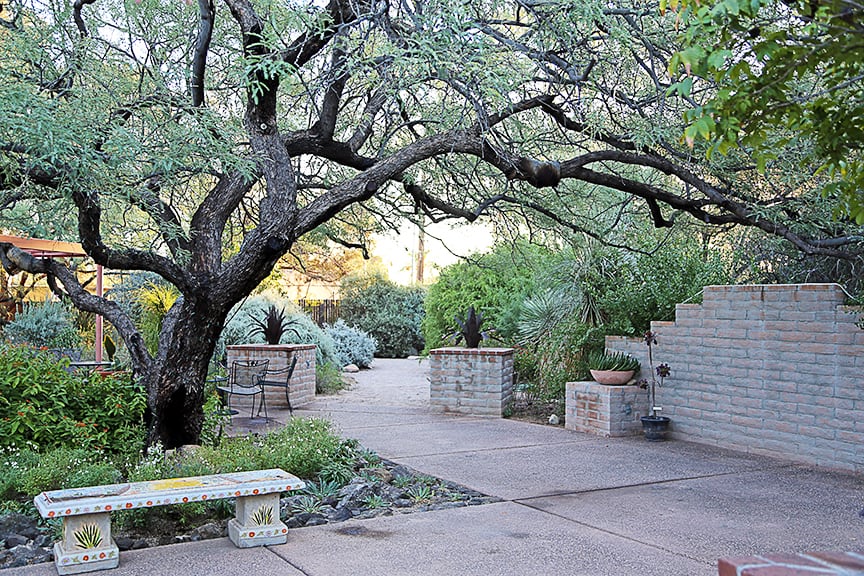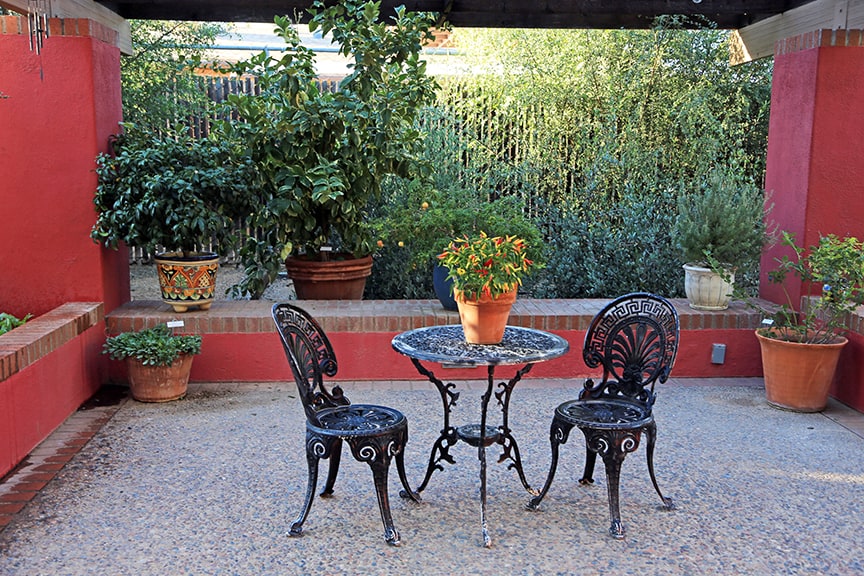When traveling, I enjoy local food, people watching and interesting, beautiful gardens. Sometimes the gardens I visit are common tourist destinations, but in other instances the existence of a garden is an unexpected and delightful surprise.
La Scarzuola
While in Italy, a chance conversation with a nun in Rome led us to visit La Scarzuola in Umbria. “I won’t tell you about it,” she said, “but you just have to go!” We made arrangements to visit this unique private property and upon arrival our tour began in a lush tangle of growth in the side gardens. These were a verdant contrast to the surreal and dramatic mixture of art, gardens and architecture that were to come.

The eye on this wall holds a surprise for visitors. When you go, be sure to look up close.
La Scarzuola takes its name from la scarza, a indigenous marsh plant that Saint Francis is reputed to have used to build a shelter on this spot in the early 1200’s. Later a Franciscan monastery was constructed in this location and in 1957 the Italian architect and artist Tomaso Buzzi purchased the property and began to build his “Ideal City.”
We toured this dreamlike mix of plants, buildings and sculpture with Buzzi’s nephew, Marco Solari, who inherited the property following his uncle’s death in 1980. The history of this sculpture park is as interesting and quirky as the architecture itself. We learned, for example, that Buzzi constructed much of his ideal city in the nude, a strategy designed to keep nosy neighbors from disturbing his work.

Our tour of this Ideal City began in a lush side garden.
La Scarzuola is now open by appointment only. As the website says, call ahead and if you don’t get an answer, keep trying many times. It’s worth it.

This section of La Scarzuola encloses a dead tree, not visible in this photo, that was purposefully left in place.
Gardening On The Steps of the Parliament
I discovered an equally surprising, but totally twenty-first century garden on the grounds of The National Assembly in Quebec City. A group of volunteers known as The Urbainculteurs have a mission to promote urban gardening and to show that food can be grown anywhere. In 2013 they planted over 130 varieties of plants, some in the ground and some in black fabric Smart Pots.
Smart Pots are light-weight so they can be easily transported, even up to rooftops. Once filled with soil they create instant raised beds. There are sizes deep enough for root crops such as potatoes, or for creating ornamental arches with willow stems.

In several areas live willow poles were stuck into large Smart Pots and bent together to mark entrances.
In addition to plants both edible and ornamental, The Urbainculteurs have installed bee hives on the roof of The Parliament Building as part of the an “Urban Honey” project. The gardens demonstrate that even on hard, cement surfaces or in small spaces those living in cities can grow a great deal of food.

Some of the vegetables were placed in the ground, and others grown in raised beds or Smart Pots.
The produce harvested from these urban plantings isn’t just important because it’s edible. Installing vegetable gardens in public places also keeps city dwellers more generally familiar with how their food is raised. In locations such as government buildings it’s also meaningful to have visual reminders of present day local farming and agricultural traditions.

My favorite plantings were the large Smart Pot containers that lined the wide steps leading to the Parliament Building.
Tucson Botanical Garden
The Tucson Botanical Gardens in Arizona is in an environment completely opposite from that of Quebec City, but they are also dedicated to creating beautiful and educational gardens. This Tucson non-profit celebrates local history, indigenous people, and the plants that thrive in hot, dry climates.

Although the Tucson Botanical Garden isn’t huge, you can wander here for hours.
The Nuestro Jardin honors traditional Mexican-American neighborhood gardens with arrangements of colorful plants and objects typical to barrio landscapes. The Native Crops Garden keeps visitors familiar with useful plants grown by indigenous populations with an emphasis on those crops grown the Tohono O’odham.
Although we might think of desserts as being dry, rather desolate places, the TBG is filled with an array of beautiful, often sculptural plants that thrive in this climate. Wandering the grounds of this botanical garden I lost track of time as I discovered vivid flowers, birds nesting among thorns, ideas for patio plantings and plants of historical and cultural interest.

One of the extremely useful display areas is a section with different themed patios. Arizona residents are sure to be inspired by these outdoor living displays and the plants they contain.
These three gardens are just a small sampling of the historically interesting and artistically appealing landscapes that thrive in unexpected places. Next time you travel and sit down to a great local meal, ask those around you the following question: “Are there any unexpected gardens in the area? Who’s growing something unusual or artistic?”

Cactus spikes protect fragile eggs in one of the many nests spied in the Tucson Botanical Gardens



